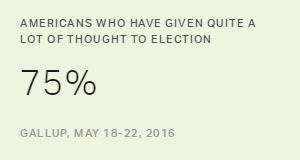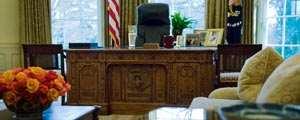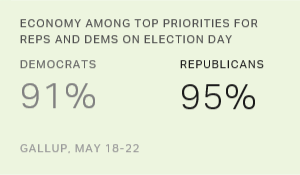Story Highlights
- 75% of Americans have given "quite a lot" of thought to the election
- Republicans, as is typical, are more likely to have given it a lot of thought
- 48% are less enthusiastic than usual about voting, 46% more enthusiastic
WASHINGTON, D.C. -- Three in four Americans are giving "quite a lot" of thought to the upcoming presidential election, a possible sign of high voter turnout this November. In the 2008 presidential campaign that produced the highest voter-turnout percentage in 40 years, a late-May poll showed a level of interest similar to this year's. In the lower-turnout 2000 and 2004 elections, smaller percentages said in May that they had given quite a bit of thought to the election.
| Quite a lot | Only a little | Turnout percentage, Election Day | |||||||||||||||||||||||||||||||||||||||||||||||||||||||||||||||||||||||||||||||||||||||||||||||||
|---|---|---|---|---|---|---|---|---|---|---|---|---|---|---|---|---|---|---|---|---|---|---|---|---|---|---|---|---|---|---|---|---|---|---|---|---|---|---|---|---|---|---|---|---|---|---|---|---|---|---|---|---|---|---|---|---|---|---|---|---|---|---|---|---|---|---|---|---|---|---|---|---|---|---|---|---|---|---|---|---|---|---|---|---|---|---|---|---|---|---|---|---|---|---|---|---|---|---|---|
| % | % | % | |||||||||||||||||||||||||||||||||||||||||||||||||||||||||||||||||||||||||||||||||||||||||||||||||
| 2016 | 75 | 21 | N/A | ||||||||||||||||||||||||||||||||||||||||||||||||||||||||||||||||||||||||||||||||||||||||||||||||
| 2008 | 73 | 20 | 58.2 | ||||||||||||||||||||||||||||||||||||||||||||||||||||||||||||||||||||||||||||||||||||||||||||||||
| 2004 | 64 | 29 | 56.7 | ||||||||||||||||||||||||||||||||||||||||||||||||||||||||||||||||||||||||||||||||||||||||||||||||
| 2000 | 42 | 43 | 51.2 | ||||||||||||||||||||||||||||||||||||||||||||||||||||||||||||||||||||||||||||||||||||||||||||||||
| Question on thought given to the election was not asked in May-June 2012 | |||||||||||||||||||||||||||||||||||||||||||||||||||||||||||||||||||||||||||||||||||||||||||||||||||
| May Gallup polls in 2000, 2004, 2008 and 2016; The American Presidency Project, Voter Turnout in Presidential Elections | |||||||||||||||||||||||||||||||||||||||||||||||||||||||||||||||||||||||||||||||||||||||||||||||||||
Fewer than half of Americans in May 2000 were paying a lot of attention to that year's presidential election, and the turnout reflected the lack of interest. About half of eligible voters (51.2%) cast a ballot, the third-lowest turnout rate (ahead of 1996 and 1988) since 1924.
Gallup did not measure thought about the election in the May-June period of the 2012 election, which produced a 54.9% turnout rate. In a July poll that year, 64% said they were thinking about the election quite a lot -- fewer than in July 2008, about the same as in July 2004 and more than in July 2000.
Democrats and Republicans Giving More Thought to Election Than in January
The current level of thought Americans are giving to the election is significantly higher than before the first presidential primaries in February. Seventy-nine percent of Republicans, including independents who lean Republican, now say they have given quite a lot of thought to the election, up from 70% in January. Democrats and Democratic leaners are also more likely to say they are thinking about the election: 72% say "quite a lot" now, up from 63% in January.
Republicans are more likely than Democrats to say they are following the race closely, continuing a pattern seen in previous campaigns. Even in the final days of the Democratic victories in the 2008 and 2012 presidential elections, Republicans were more likely than Democrats to say they were thinking about the election quite a lot. Republicans also are following election news more closely, according to a May 13-15 Gallup poll.
Americans Split on Whether Their Enthusiasm Is Higher or Lower Than in Past
Though Americans are giving a lot of thought to the election, they are split on whether they are more enthusiastic (46%) or less enthusiastic (48%) about voting this year compared with prior election years. The only time Gallup asked this question in May or June of a presidential campaign year was during the high-turnout 2008 election. In a June 15-19 poll that year, about the same percentage (48%) said they were more enthusiastic as said so this year, but significantly fewer (37%) said they were less enthusiastic.
Republicans today are far more enthusiastic than in June 2008, when incumbent Republican President George W. Bush's approval rating was below 30%. Then, only 35% of Republicans and leaners said they were more enthusiastic than usual, and 51% were less enthusiastic. Now, 51% of Republicans are more enthusiastic and 43% less enthusiastic.
For Democrats and leaners, the situation is reversed. In June 2008, with Barack Obama on the way to being their party's nominee, 61% were more enthusiastic and 25% less enthusiastic. Now, 43% are more enthusiastic and 50% less.
| All adults | Democrats and leaners | Republicans and leaners | |||||||||||||||||||||||||||||||||||||||||||||||||||||||||||||||||||||||||||||||||||||||||||||||||
|---|---|---|---|---|---|---|---|---|---|---|---|---|---|---|---|---|---|---|---|---|---|---|---|---|---|---|---|---|---|---|---|---|---|---|---|---|---|---|---|---|---|---|---|---|---|---|---|---|---|---|---|---|---|---|---|---|---|---|---|---|---|---|---|---|---|---|---|---|---|---|---|---|---|---|---|---|---|---|---|---|---|---|---|---|---|---|---|---|---|---|---|---|---|---|---|---|---|---|---|
| % | % | % | |||||||||||||||||||||||||||||||||||||||||||||||||||||||||||||||||||||||||||||||||||||||||||||||||
| May 18-22, 2016 | |||||||||||||||||||||||||||||||||||||||||||||||||||||||||||||||||||||||||||||||||||||||||||||||||||
| More enthusiastic | 46 | 43 | 51 | ||||||||||||||||||||||||||||||||||||||||||||||||||||||||||||||||||||||||||||||||||||||||||||||||
| Less enthusiastic | 48 | 50 | 43 | ||||||||||||||||||||||||||||||||||||||||||||||||||||||||||||||||||||||||||||||||||||||||||||||||
| Jun 15-19, 2008 | |||||||||||||||||||||||||||||||||||||||||||||||||||||||||||||||||||||||||||||||||||||||||||||||||||
| More enthusiastic | 48 | 61 | 35 | ||||||||||||||||||||||||||||||||||||||||||||||||||||||||||||||||||||||||||||||||||||||||||||||||
| Less enthusiastic | 37 | 25 | 51 | ||||||||||||||||||||||||||||||||||||||||||||||||||||||||||||||||||||||||||||||||||||||||||||||||
| Gallup | |||||||||||||||||||||||||||||||||||||||||||||||||||||||||||||||||||||||||||||||||||||||||||||||||||
There have been three other notable shifts in enthusiasm from 2008 to now:
- In 2008, Gallup measured Americans' enthusiasm to vote just after Hillary Clinton gave up her bid for the Democratic nomination; this year's poll was conducted as she stood on the threshold of becoming the first female presidential nominee of a major party. Nevertheless, among Democratic and Democratic-leaning women, 59% in 2008 were more enthusiastic than usual about voting and 31% were less enthusiastic. But this year, 40% are more enthusiastic and 53% are less enthusiastic.
- Among ideological moderates from either party, 48% were more enthusiastic than usual in 2008 and 39% less enthusiastic. Now 38% are more enthusiastic and 56% less enthusiastic.
- Conservatives' enthusiasm has grown, while liberals' has faded. Fifty-two percent of conservatives are more enthusiastic this year, compared with 40% in 2008; at the same time, 48% of liberals are more enthusiastic now, compared with 63% in 2008.
Enthusiasm could grow in both parties. With the interparty battles of the primary season ending, the parties can switch their emphasis to healing internal wounds and attacking the other party's nominee. The fall campaign may also help energize voters in both parties -- in the last three presidential election years, enthusiasm within the parties tended to peak in the month before the election.
Bottom Line
It is no surprise that a campaign with two heated battles for party nominations, each dominated by a candidate who has been among the nation's best-known public figures for decades, has drawn the attention of most Americans. It also is no surprise, with both Clinton and Donald Trump holding unusually high unfavorable ratings, that nearly half of Americans say they are less enthusiastic than usual about voting. Both nominees face the dual challenges of winning back support within their own party from campaign opponents and those opponents' supporters as well as improving their images with the general public.
The 2016 election has Americans pondering their choices with a focus similar to that of the high-turnout 2008 campaign, but there is a fundamental difference. Fewer than four in 10 Americans have a favorable view of either Clinton or Trump. At the beginning of June 2008, 58% viewed eventual Democratic nominee Barack Obama favorably, and 56% held that view of presumptive Republican nominee John McCain.
With the public engaged by the campaign but not favorably disposed toward the two major-party candidates, it is unclear whether high interest in the election will result in high turnout, or whether the current low regard for the candidates will lead to low turnout in November. Turnout may depend on the extent to which the candidates can change the public's views of them and can turn animosity toward their opponent into turnout at the polls for themselves.
Survey Methods
Results for this Gallup poll are based on telephone interviews conducted May 18-22, 2016, with a random sample of 1,530 adults, aged 18 and older, living in all 50 U.S. states and the District of Columbia. For results based on the total sample of national adults, the margin of sampling error is ±3 percentage points at the 95% confidence level. For results based on the total samples of 697 Democrats and Democratic-leaning independents and 744 Republicans and Republican-leaning independents, the margin of sampling error is ±5 percentage points at the 95% confidence level. All reported margins of sampling error include computed design effects for weighting.
Each sample of national adults includes a minimum quota of 60% cellphone respondents and 40% landline respondents, with additional minimum quotas by time zone within region. Landline and cellular telephone numbers are selected using random-digit-dial methods.
View survey methodology, complete question responses and trends.
Learn more about how the Gallup Poll Social Series works.




